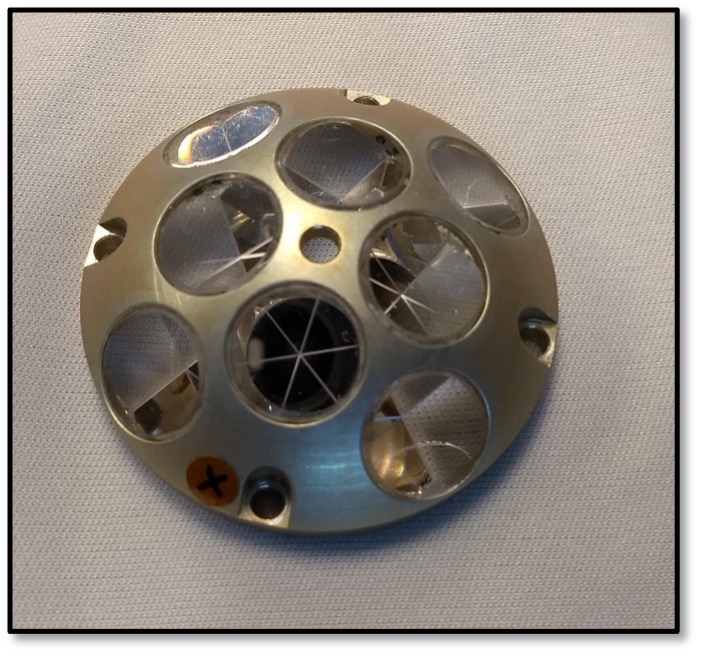NASA GSFC Miniature Laser Retroreflector Arrays
Daniel Cremons
NASA Goddard Space Flight Center (GSFC) has developed a series of miniature Laser Retroreflector Arrays (mini-LRAs) for deployment on the Moon and other planetary bodies to act as fiducial markers for decades of laser ranging. Placement of a small LRA on the deck of a lander, rover, or a deployed instrument enables tracking with an orbital laser altimeter with a precision on the order of centimeters. An optical marker observable from orbit mounted alongside a suite of scientific instruments on the surface enables geolocation of those instruments in the lunar geodetic frame. In addition, LRAs can in turn be used to validate geolocation and ranging performance of orbital laser altimeters. Knowledge of the precise location of the array and the lander on the lunar surface is beneficial for orbit reconstruction, navigation, and broader exploration goals. Finally, optical markers such as LRAs can support precision autonomous navigation and landing without specific lighting conditions.
The NASA GSFC mini-LRAs are small, passive devices which require no power, commanding, data downlink, or thermal control. They are hemispherical in shape, with a diameter of 5.11 cm (2.01 inches), a height of 1.65 cm (0.65 inches), and a mass of 20 g (0.71 ounces). Each mini-LRA contains eight corner cube retroreflector (CCR) prisms which operate via total internal reflection and each with an acceptance angle of 17 degrees. The eight CCRs are arranged in two concentric rings; the first ring is at 20 degrees from zenith and the second at 40 degrees. This enables the array to have an overall acceptance angle of any azimuth angle and at elevations above 30 degrees from the mounting plane. Below is an image of the one of the mini-LRAs prior to thermal vacuum testing at NASA GSFC.

GSFC mini-LRAs have flown on several Commercial Lunar Payload Services (CLPS) missions as well as lunar lander missions from other space agencies such as the Indian Space Research Organisation (ISRO), Japan Aerospace Exploration Agency (JAXA), and the Israeli SpaceIL Beresheet mission.
Further information and quantitative data about the mini-LRAs on CLPS missions can be found in the Planetary Data System Geoscience Node LRA Bundle (https://pds-geosciences.wustl.edu/missions/clps/lra.htm). This includes optical test data, location of the LRA on the lander, orientation, local topography, and the quantitative return strength (optical cross section) of the LRA as a function of viewing angle. Together these values can be used to enable targeting of the mini-LRAs from an orbital or landing laser altimeter or lidar.
Data Description
We intend this page to act as an up-to-date catalog of all flown or planned GSFC mini-LRAs. Below is a table of mini-LRA missions in chronological order including the landing date, LRA status, surface location, and if the deployment was verified with successful ranging with the Lunar Orbiter Laser Altimeter (LOLA), the only currently operating orbital laser altimeter.| Mission Number | Mission (Org.) | Launch Date | Status | Surface Location | Deployment Verified with LOLA |
| 1 | Beresheet (SpaceIL) | February 21, 2019 | Inoperative | 32.5956°N, 19.3496°E | N/A |
| 2 | Chandrayaan-2 (ISRO) | July 22, 2019 | Inoperative | 70.8810°S, 22.7849°E | N/A |
| 3 | Chandrayaan-3 (ISRO) | July 14, 2023 | Nominal Deployment | 69.3735°S, 32.3199°E | Yes |
| 4 | SLIM (JAXA) | September 6, 2023 | Off-Nominal Deployment | 13.31549°S, 25.24889°E | Yes |
| 5 | CLPS Peregrine Mission 1 (Astrobotic) | January 8, 2024 | Inoperative | N/A | N/A |
| 6 | CLPS Intuitive Machines-1, Odysseus (Intuitive Machines) | February 15, 2024 | Off-Nominal Deployment | 80.1277°S, 1.4357°E | No |
| 7 | CPLS Intuitive Machines-2, PRIME-1, Athena (Intuitive Machines) | February 26, 2025 | Off-Nominal Deployment | 84.7754°S, 29.1264°E | No |
| 8 | CLPS Griffin Mission 1 (Astrobotic) | 2025 | Mons Mouton | ||
| 9 | FLIP rover (Venturi Astrolab) | 2025 | Mons Mouton | ||
| 10 | Blue Moon Mk-1, CT-3 (Blue Origin) | 2025 | South Pole Region | ||
| 11 | CLPS Intuitive Machines-4, CP-22 (Intuitive Machines) | 2027 | Mons Mouton | ||
| 12 | CLPS Blue Ghost Mission 4, CS-6 (Firefly Aerospace) | 2029-2030 | South Pole Region |
This maps shows the NASA GSFC mini-LRAs on the Lunar surface, as of September 2025.

Click to view full-resolution image.
The large Apollo LRAs, Lunokhod LRAs, large corner cubes (e.g., NGLR on Blue Ghost Mission 1), and non-NASA mini-LRAs are not shown.
Data Usage Policy
Please cite the following references when using any of the data described above:Sun, X. et al. 2019. "Small and Lightweight Laser Retro-Reflector Arrays for Lunar Landers." Applied Optics 58 (33): 9259-9266 doi:10.1364/AO.58.009259.
Cremons, D. R. et al. 2020. "Optical Characterization of Laser Retroreflector Arrays for Lunar Landers." Applied Optics 59 (16): 5020-5031 doi:10.1364/AO.388371.
Cremons, D. R. (2025). NASA GSFC Miniature Laser Retroreflector Arrays [Data set]. NASA Goddard Space Flight Center Planetary Geodesy Data Archive. doi:10.60903/GSFC-miniLRAs.